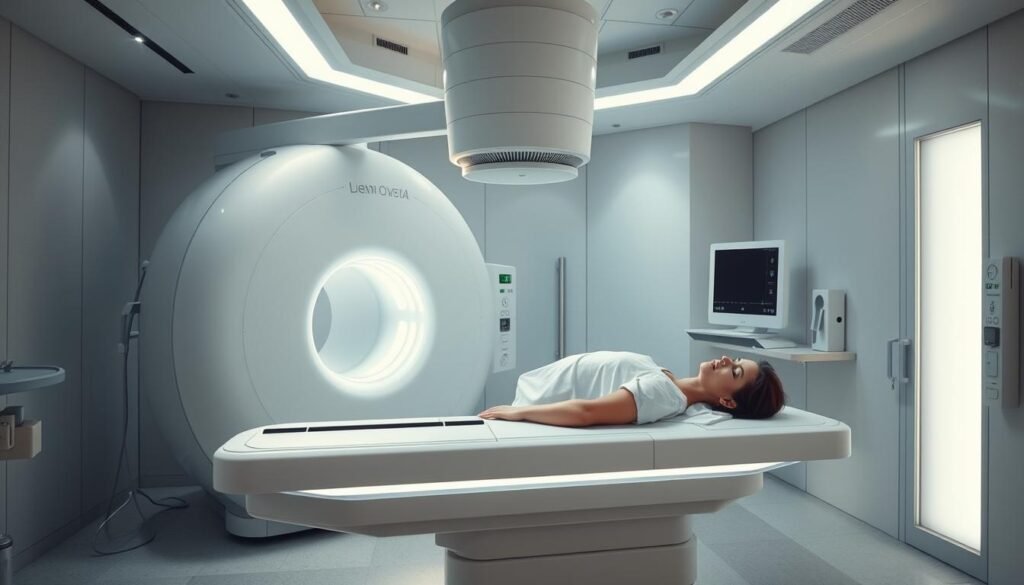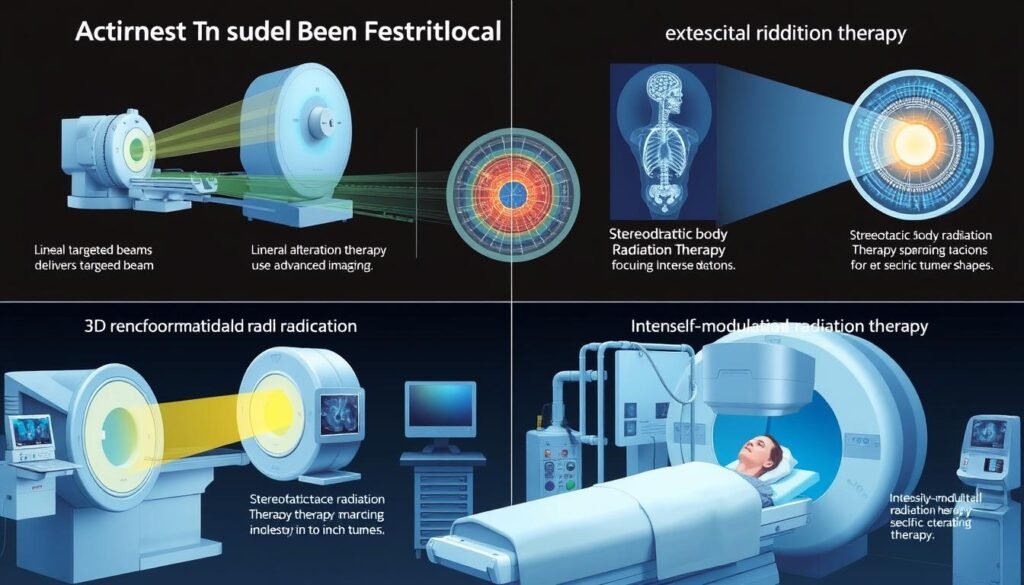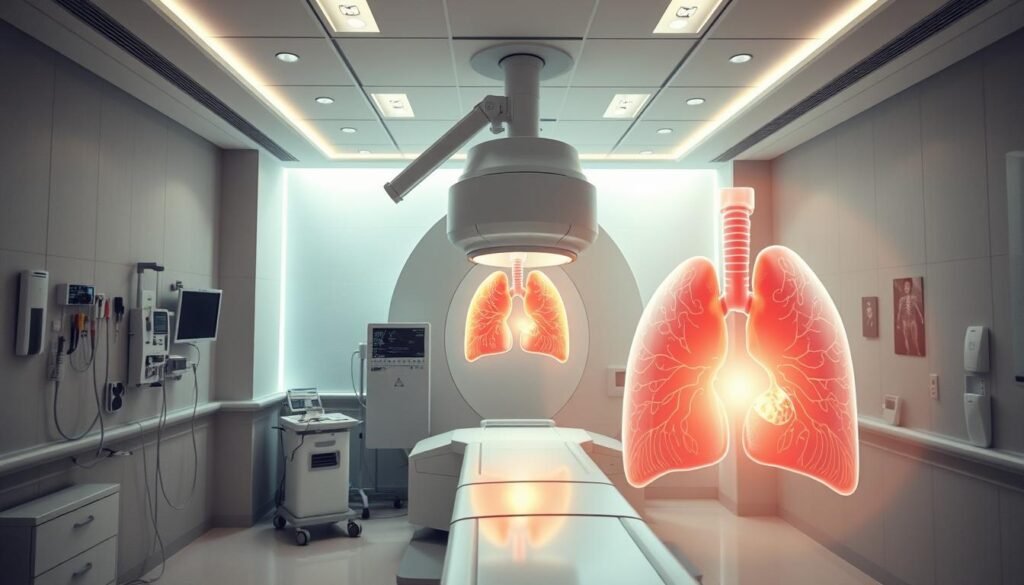Did you know external beam radiation therapy (EBRT) is a top choice for treating non-small cell lung cancer (NSCLC)? It uses high-energy rays to target and kill cancer cells in the lungs. As lung cancer rates climb, it’s vital for patients and caregivers to understand radiation oncology. This guide explains how EBRT works, its forms, and why it’s important in fighting lung tumors.
Key Takeaways
- External beam radiation therapy is crucial in treating non-small cell lung cancer and its metastasis.
- Different techniques, like 3D conformal radiation therapy and intensity-modulated radiation therapy, enhance treatment precision.
- Radiation treatments are usually administered five days a week, with variations based on the patient’s condition.
- Proton therapy offers advantages in minimizing damage to surrounding normal tissues during treatment.
- Patients can experience side effects, such as fatigue and skin changes, but management strategies are available.
Overview of Lung Cancer Treatment Options
Lung cancer treatment can vary greatly. It depends on the cancer’s type and stage. This includes non-small cell lung cancer and small cell lung cancer. For early-stage lung cancer, surgery is usually the main treatment. Yet, there are other options for those who can’t undergo surgery.
External beam radiation is key among these alternatives. It uses high-energy x-rays to attack cancer cells. It also helps ease symptoms. Treatments are short and painless, happening about five times a week. It’s often chosen for tumors that can’t be operated on.
There are more treatments like chemotherapy, brachytherapy, and proton therapy. Chemotherapy is used alongside radiation for advanced cancers. Brachytherapy places radiation right at the tumor, protecting healthy tissue. Proton therapy, on the other hand, doesn’t harm surrounding tissue.
The choice of treatment depends on many things. These include the tumor’s type and stage, and the patient’s health. Hypofractionated radiation therapy shortens treatment time significantly. It allows patients to complete treatment in about 1½ weeks.
Learn more about the different lung cancer treatments available. See how they could help in specific cases.
What is External Beam Radiation Therapy?
External beam radiation therapy (EBRT) fights lung cancer without surgery. It sends high-energy beams to kill cancer cells, while saving healthy tissue. It’s like a super-powered X-ray.
EBRT sessions are short and may go with other treatments, like chemotherapy. These methods together can better attack lung cancer. A skilled team plans the treatment to make it as effective as possible.
Treatment happens five days a week, for two to nine weeks. Each visit lasts 15 to 30 minutes, focusing on precise patient positioning. The process doesn’t hurt. Patients might hear the machine, but they won’t feel anything.
EBRT is a top choice for treating lung cancer. It not only targets tumors but can lessen cancer pain. Regular check-ups after treatment are crucial. They help track how the tumor is responding and handle any side effects.

How External Beam Radiation Targets Lung Tumors
External Beam Radiation Therapy (EBRT) is a game changer in fighting lung cancer. It uses high-energy rays to target tumors accurately. A team of specialists works closely to plan and deliver this treatment, helping patients effectively.
Mechanism of Action
The core of EBRT is to damage the cancer cells’ DNA. It stops their ability to grow, controlling the tumor. This method focuses on killing cancer cells, aiming to protect the healthy cells nearby.
Precision and Targeting Techniques
Technology has made external beam radiation more precise. Methods like Image-Guided Radiation Therapy (IGRT) and Stereotactic Body Radiation Therapy (SBRT) are tailored to each patient. They track the tumor’s movement, ensuring accurate targeting with less harm to healthy cells.
Treatments are often short, about 15 to 30 minutes, over weeks. This allows for precise, consistent care. A team, including radiation oncologists and medical physicists, works together to ensure successful outcomes.
EBRT is a detailed and flexible way to tackle lung cancer. It merges cutting-edge technology with tailored patient care. For more details, visit this resource.
Different Types of External Beam Radiation
External beam radiation therapy uses several techniques. Each one aims to target tumors accurately while saving the healthy tissue around them. Knowing about the different external beam radiation types helps patients choose their treatment wisely.
3D Conformal Radiation Therapy
3D conformal radiation therapy makes a 3D model of the tumor using advanced imaging. It shapes radiation beams to fit the tumor’s form. This approach gives the most radiation to the cancer while protecting nearby healthy tissue. Its adaptability to complex shapes makes it a standout choice.
Intensity-Modulated Radiation Therapy (IMRT)
IMRT enhances conformal therapy by changing the radiation beams’ strength. It allows high-radiation doses to hit the tumor while saving crucial areas close by. IMRT is highly precise, making it great for tumors in sensitive spots.
Stereotactic Body Radiation Therapy (SBRT)
SBRT is for early-stage tumors and uses fewer radiation sessions. It targets very accurately with advanced imaging, working in one to five sessions. SBRT is highly effective for tumors in the lungs and spine among other places.
Image-Guided Radiation Therapy (IGRT)
IGRT improves accuracy with real-time imaging during therapy planning and delivery. This method is good for tumors that move, like in the lungs, or near vital organs. By adjusting to the tumor’s changing position and size, IGRT achieves better targeting and results.

| Type of Radiation Therapy | Description | Advantages |
|---|---|---|
| 3D Conformal Radiation Therapy | Shapes beams to match tumor contours | Minimizes damage to healthy tissue |
| Intensity-Modulated Radiation Therapy (IMRT) | Varying intensity of beams for targeted delivery | Higher doses to tumors, protects surrounding structures |
| Stereotactic Body Radiation Therapy (SBRT) | High doses of radiation in fewer sessions | Highly effective for specific tumors, quick treatment |
| Image-Guided Radiation Therapy (IGRT) | Uses real-time imaging for precise targeting | Adapts to changes in tumor position, enhanced accuracy |
When is Radiation Therapy Recommended?
Radiation therapy plays a key role in treating lung cancer. It helps in different cases, depending on the patient’s specific needs. Some reasons to use radiation include treating tumors that can’t be removed by surgery, easing symptoms as palliative care, or killing leftover cancer cells after surgery.
Lung cancer treatment guidelines suggest using radiation along with chemotherapy. This approach works best for types of lung cancer like NSCLC and SCLC. It’s crucial to know the tumor’s stage and type to decide if radiation is right.
For early-stage cancers, doctors might use radiation first to shrink tumors before surgery. In advanced stages, it helps ease symptoms caused by the tumor’s growth. When surgery isn’t an option, radiation can be the main way to treat the cancer.
The treatment often lasts several weeks. Patients usually go for treatment five days a week. This schedule helps make the treatment more effective and reduces side effects. Each approach is chosen based on what’s best for the patient’s health, the cancer type, and tumor specifics.
| Indication for Radiation Therapy | Purpose |
|---|---|
| Primary Treatment for Inoperable Tumors | Addresses tumors that cannot be surgically removed. |
| Post-Surgery | Eliminates remaining cancer cells and reduces recurrence risk. |
| Palliative Care | Relieves symptoms in advanced stage cancers. |
| Neoadjuvant Therapy | Reduces tumor size before surgical intervention. |
| Combination with Chemotherapy | Enhances overall treatment effectiveness. |
Benefits of External Beam Radiation Therapy
External beam radiation therapy, or EBRT, is key in treating lung tumors. It has many benefits that make treatments more effective. About 60% to 70% of cancer patients will get radiation therapy at some point.
EBRT is great because it can shrink tumors and ease symptoms of lung cancer. This helps patients feel less pain and breathe more easily, which betters their lives. Combining EBRT with treatments like chemotherapy and surgery can also raise survival chances.
Technology has made EBRT delivery better. Image-guided radiation therapy (IGRT) is one such advancement. It lets doctors target tumors more accurately, protecting healthy tissue. This means better results for patients and fewer side effects.
- Reduced Tumor Size: Targeted radiation helps make tumors smaller, helping with surgery.
- Palliative Effects: It relieves pain and helps patients breathe easier.
- Combination Therapy: Works with chemotherapy to improve how effective treatment is.
EBRT is a top choice for treating both early and advanced lung cancer. Careful planning and precise treatment are vital. This ensures patients get the most out of radiation therapy with fewer risks.

Potential Side Effects of Radiation Treatment
Patients getting external beam radiation for lung cancer often face side effects. Knowing about these effects helps patients get ready for treatment. The kind and harshness of side effects change with the radiation dose and treated area.
Common Side Effects
Early side effects of radiation therapy include:
- Fatigue
- Skin changes such as redness and irritation
- Hair loss in the targeted area
- Mouth problems like sores and dryness
Late side effects can show up months or years after treatment. For instance, radiation to the chest might cause breathing problems. Treating the brain may lead to thinking issues. For more on these reactions, see this resource.
Management of Side Effects
Handling radiation side effects is key to making patients comfortable. Doctors might suggest ways to ease lung cancer treatment side effects. Medicine for sickness and changes in diet are important. Regular check-ups let doctors keep an eye on side effects and tweak treatments.
In certain situations, drugs like amifostine can reduce side effects in targeted therapies. Knowing about these side effects and how to manage them gives patients control during treatment.
For more details on adenocarcinoma and its link to lung cancer, go to this link.
Preparing for External Beam Radiation Therapy
Getting ready for radiation therapy is key to successful treatment. First, a session called a simulation may be planned. In this session, experts use special imaging to find the patient’s position precisely. This step is crucial for hitting the tumor perfectly during treatment. It helps the medical team create a custom plan for the patient.
The doctors will then go over the treatment plan with the patient. They will talk about how many sessions are needed, which can range from a day to seven weeks. They will also cover possible side effects like tiredness, skin issues, and trouble swallowing. Knowing what to expect can help patients feel more comfortable as they start treatment.
It’s also important to eat well and keep your energy up during this time. Good food can really help your health while getting treated. Patients who know what’s going on and feel in control do better. They can take an active part in their fight against cancer.